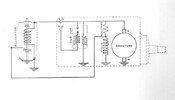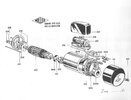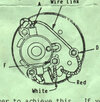Chris, Do you have any information you can share about tuning and adjusting (or even how it works) of the Miller CV1 Voltage Regulator? I have an interest in getting to know them better. Thank you.
You are using an out of date browser. It may not display this or other websites correctly.
You should upgrade or use an alternative browser.
You should upgrade or use an alternative browser.
Misc: Charging Systems Battery Charging Help!
- Thread starter pmcmanners
- Start date
Any trick on how to test the dynamo
Most of these have now been converted to electronic regulators, which requires changing the internal wiring (simplifying), and removing the cutout device found under the dynamo cap. With the simpler wiring, you test the dynamo by disconnecting the regulator, jumping the two output wires 'F' (field coil) and 'D' (armature output) together, spinning the unit and observing voltage output (between dynamo case earth and the jumped wires). The jumper effectively sets the dynamo to full output; you should get at least 7V at less than 3000 rpm. (Don't let it rise much higher.)
I've not tried this on a dynamo with the original wiring, but it may work.
First try the "motor" test described in the article, though. This also "flashes" the field coil, magnetizing it slightly. Loss of this magnetism is sometimes the cause of no output.
If the dynamo has no output, it may respond to simple measures like cleaning the commutator or replacing the brushes. Worst case, you may need to replace the field coil (unlikely) or armature; not rocket science, and cheaper than replacing it with an Alton.
Attached is some doco; the article focuses on Lucas dynamos, but Miller is very similar. One difference is the cutout is in the Lucas regulator box, but inside the dynamo cap on the Miller.
Attachments
Hi LoneStar - Nice articles - thank you.
Follow LoneStar's advice if you can but you might find it much easier to take the dynamo off the bike to play with. You can, for example, clean the commutator on the armature with everything in place by just removing the end cap of the dynamo. The commutator is the thing with lots of segments and these get covered in carbon dust from the brushes and oil from anywhere. A petrol soaked cloth will remove the dirt. Just hold the cloth against the commutator while someone carefully kicks the engine over. In addition the carbon brushes wear and can get stuck in their housings so you need to make sure that one or both has not worn down so much that it is not touching the commutator and that neither has stuck. They are spring loaded and the springs could be weak or even broken. Have a go at these ideas and then come back with the results. You might just get lucky but that cylindrical regulator should go. They were a pain in the rear seventy years ago.
One of the failure modes of the CV1 regulator is for the lower contact, as shown on Lone Stars circuit diagram, to weld permanently closed. This results in no output from the dynamo, because the Field Coil is shorted to ground.
In order to test the dynamo, it is best to disconnect the regulator, and connect the two wires together. This will short out the dynamos internal resistor. Then connect a volt meter between the body of the dynamo and the junction of the two wires. Start the engine. The voltage should rise with engine revs. Be careful not to rev too high. Keep the voltage to a safe level for the old insulation. No more than nine volts is enough to prove that the dynamo is capable of charging the battery.
In order to test the dynamo, it is best to disconnect the regulator, and connect the two wires together. This will short out the dynamos internal resistor. Then connect a volt meter between the body of the dynamo and the junction of the two wires. Start the engine. The voltage should rise with engine revs. Be careful not to rev too high. Keep the voltage to a safe level for the old insulation. No more than nine volts is enough to prove that the dynamo is capable of charging the battery.
Reading the material provided, it appears the long adjusting screw running through the center of CV1 is the plunger of a solenoid mechanism to open and close a set of points which direct or disable current flow to the field coils to affect the generator output. As opposed to the Lucas design (and most mechanical automotive voltage regulators) of a solenoid above the contacts. Is that correct? Thank you.
I would like to say if you only do some local short riding with the bike then it could be okay with the original dynamo. But if you like to do long distance tours then you should try to get the most reliable systems .And this means you should think about not only the electric parts of your motorcycle.Erik
Hi Texas John. I don't want to start a discussion about the Miller regulator in the middle of Paul's topic. It could cause confusion.Chris, Do you have any information you can share about tuning and adjusting (or even how it works) of the Miller CV1 Voltage Regulator? I have an interest in getting to know them better. Thank you.
Why not start your own post; searching for info on that topic. Cheers, Chris.
Especially in the summer, riding with just a charged battery and a magneto is not too bad. An LED pilot bulb from Goffy looks good enough to use.I would like to say if you only do some local short riding with the bike then it could be okay with the original dynamo. But if you like to do long distance tours then you should try to get the most reliable systems .And this means you should think about not only the electric parts of your motorcycle.Erik
We have just done this and the reading on voltmeter is all over the place. Meter range set to 20v (DC) and the readings go from 0v to over 20v and anything in between constantly - any ideas?One of the failure modes of the CV1 regulator is for the lower contact, as shown on Lone Stars circuit diagram, to weld permanently closed. This results in no output from the dynamo, because the Field Coil is shorted to ground.
In order to test the dynamo, it is best to disconnect the regulator, and connect the two wires together. This will short out the dynamos internal resistor. Then connect a volt meter between the body of the dynamo and the junction of the two wires. Start the engine. The voltage should rise with engine revs. Be careful not to rev too high. Keep the voltage to a safe level for the old insulation. No more than nine volts is enough to prove that the dynamo is capable of charging the battery.
Going to try and flash the dynamo now - if this does not work we will clean it up.
Here's hoping



